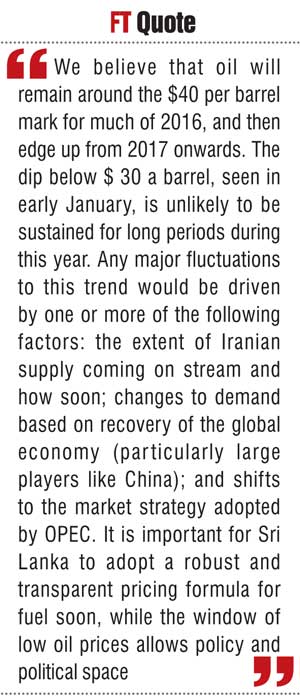Thursday Mar 06, 2025
Thursday Mar 06, 2025
Wednesday, 3 February 2016 00:00 - - {{hitsCtrl.values.hits}}
The world economy is seeing an unprecedented fall in global oil prices, now hovering at around $ 30 per barrel – levels not seen since 2003. So far this year oil prices have fallen more than 25%. In 2015, oil prices fell by 47% and are forecast to fall by a further 18% this year. In 2015, global crude oil supply grew by a staggering 2.6 million barrels a day and forecasts indicate that during the course of 2016 over supply is likely to reach around one million barrels a day. 
The main drivers of these continued low prices are: high supply from OPEC countries struggling to maintain market share; continued supply from the unconventional oil producer – the US – of shale oil/gas; new production coming on-stream from Iran; and the impact of slowdown in China and wider slowdown in aggregate demand in the global economy.
Four drivers of current dynamics
In the US, the shale oil/shale gas/tight oil revolution has made it a serious player in oil production. Technological advances have been fracking technology (hydraulic fracturing) feasible. This led to a rise in shale rigs and US becoming self-sufficient in energy, reducing (and nearly eliminating) its reliance on imported oil. Amidst lower oil prices, shale rigs (which are higher marginal cost producers) have had to consolidate, but still remain competitive. Last month, the US lifted a 40-year long ban on exports of US crude oil resources. These factors are driving higher oil inventories globally, and keeping prices low.
Meanwhile, OPEC (and Saudi Arabia more broadly) is struggling to maintain market share amidst falling prices and increasing supply from new producers. Their strategy has been to keep supply high and prices low in order to maintain market share and make US shale economically infeasible. The strategy is not working. Saudi Arabia now faces budgetary crises as generous welfare spending, which up to now had been financed with large oil surpluses during high price era, are no longer affordable. Saudi Arabia’s annual budget deficit of over $100 billion has forced the country to liquidate over $90 billion of foreign assets in the past 12 months to bridge the gap. In a probably further sign of stress, Saudi Arabia recently announced it is seeking to sell part ownership of its state-owned oil company, Saudi Aramco.
Iran is set to be the latest producer to add to the global oil glut. Sanctions on Iran had hit its oil production and export, but with the sanctions being removed Iran is set to become a major oil exporter once more. The country has been preparing for months to be ready for the lifting of sanctions, and has already begun ramping up production. It is likely that Iran will pump nearly 1.5 million barrels a day by end of 2016. Already the daily excess demand in the global oil market is close to one million barrels.
Slowing global demand has also been driving the low oil price dynamics. China’s export and investment-fuelled growth drive has been a big reason for the high demand for commodities, including oil. With a slowdown in the Chinese economy, oil commodity futures have seen lower prices as demand for oil is likely to slow down. Slowdown in other major economies like Russia and Brazil – both now firmly in recession territory with the decline in growth in 2016 estimated at -1.0% and -3.5% respectively – has also pushed down demand in recent quarters. To a lesser extent, the milder winter temperatures in Japan and Europe have also contributed to downward pressure on oil demanded for heating.
Impact on Sri Lanka
The impact on Sri Lanka is twofold – positive and negative.
The key positive impact is that, as a 100% oil importing country and oil forming one-fourth of our total import bill, Sri Lanka no doubt gains from low global oil prices. This is likely to remain throughout 2016. In the midst of a depreciation of the rupee and higher import costs, this comes as welcome respite for our balance of payments situation.
This low oil price era also provides a unique ‘breathing space’ for the government to undertake much overdue energy sector reform, which is harder in a high oil price environment. A key part of this is introducing a robust pricing formula, which is highly delayed and has been talked about for years. It is important to have a credible, transparent and predictable fuel pricing mechanism so that firms and individuals alike can adjust their economic activity accordingly. This will help consumers (firms and individuals) benefit better during oil prices drops, and will ensure state entities involved in fuel supply don’t suffer from having to keep artificially low prices during oil price rises.
The negative impacts stem from two main channels – Sri Lanka’s exports to conventional oil producing countries, and remittances to Sri Lanka from migrant workers in these economies.
Some of our major export destinations for tea – Middle East and Russia – are suffering from lower commodity (including oil) prices and this has reduced their export demand. The Middle East and Russian markets account for 62% of Sri Lanka’s tea exports by volume and 59% by value. So depressed oil revenues (and commodities in general) will have an adverse impact on the export revenues from those countries. Of course, it is not only oil prices, but also geopolitical tensions as well as the ruble collapse are also contributing to the situation.
Sri Lanka’s external sector depends heavily on remittances. Remittances provide cover for around one-third of our import bill and finances 85% of our trade balance. Budgetary strains in Gulf States due to lower oil revenues, and negative wealth effects, are hurting remittance inflows. Year-on-year remittance growth has been continuously slowing, and by end of 2015 had slowed to just 5%. About 50% of the country’s remittances (approximately $ 7 billion) come from the Middle East.
Albeit to a lesser extent, Sri Lanka would also be affected by one of the factors driving the global pullout of funds from EMs – funds from commodity (including oil) exporters, who have lower surpluses to invest overseas and particularly in riskier assets, moving away from EM equities and bonds.
Forecast for 2016
We believe that oil will remain around the $40 per barrel mark for much of 2016, and then edge up from 2017 onwards. The dip below $ 30 a barrel, seen in early January, is unlikely to be sustained for long periods during this year. Any major fluctuations to this trend would be driven by one or more of the following factors: the extent of Iranian supply coming on stream and how soon; changes to demand based on recovery of the global economy (particularly large players like China); and shifts to the market strategy adopted by OPEC. It is important for Sri Lanka to adopt a robust and transparent pricing formula for fuel soon, while the window of low oil prices allows policy and political space.
[Anushka Wijesinha is the Chief Economist of the Ceylon Chamber of Commerce (CCC). This article is based on a Research Note (January 2016) prepared by the Economic Intelligence Unit of the CCC titled ‘Unfolding Dynamics of the Global Oil Market’.]
Discover Kapruka, the leading online shopping platform in Sri Lanka, where you can conveniently send Gifts and Flowers to your loved ones for any event including Valentine ’s Day. Explore a wide range of popular Shopping Categories on Kapruka, including Toys, Groceries, Electronics, Birthday Cakes, Fruits, Chocolates, Flower Bouquets, Clothing, Watches, Lingerie, Gift Sets and Jewellery. Also if you’re interested in selling with Kapruka, Partner Central by Kapruka is the best solution to start with. Moreover, through Kapruka Global Shop, you can also enjoy the convenience of purchasing products from renowned platforms like Amazon and eBay and have them delivered to Sri Lanka.
Discover Kapruka, the leading online shopping platform in Sri Lanka, where you can conveniently send Gifts and Flowers to your loved ones for any event including Valentine ’s Day. Explore a wide range of popular Shopping Categories on Kapruka, including Toys, Groceries, Electronics, Birthday Cakes, Fruits, Chocolates, Flower Bouquets, Clothing, Watches, Lingerie, Gift Sets and Jewellery. Also if you’re interested in selling with Kapruka, Partner Central by Kapruka is the best solution to start with. Moreover, through Kapruka Global Shop, you can also enjoy the convenience of purchasing products from renowned platforms like Amazon and eBay and have them delivered to Sri Lanka.